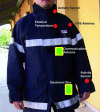A review of wearable sensors and systems with application in rehabilitation
- PMID: 22520559
- PMCID: PMC3354997
- DOI: 10.1186/1743-0003-9-21
A review of wearable sensors and systems with application in rehabilitation
Abstract
The aim of this review paper is to summarize recent developments in the field of wearable sensors and systems that are relevant to the field of rehabilitation. The growing body of work focused on the application of wearable technology to monitor older adults and subjects with chronic conditions in the home and community settings justifies the emphasis of this review paper on summarizing clinical applications of wearable technology currently undergoing assessment rather than describing the development of new wearable sensors and systems. A short description of key enabling technologies (i.e. sensor technology, communication technology, and data analysis techniques) that have allowed researchers to implement wearable systems is followed by a detailed description of major areas of application of wearable technology. Applications described in this review paper include those that focus on health and wellness, safety, home rehabilitation, assessment of treatment efficacy, and early detection of disorders. The integration of wearable and ambient sensors is discussed in the context of achieving home monitoring of older adults and subjects with chronic conditions. Future work required to advance the field toward clinical deployment of wearable sensors and systems is discussed.
Figures







References
-
- Goonewardene SS, Baloch K, Sargeant I. Road traffic collisions-case fatality rate, crash injury rate, and number of motor vehicles: time trends between a developed and developing country. Am Surgeon. 2010;76:977–981. - PubMed
Publication types
MeSH terms
Grants and funding
LinkOut - more resources
Full Text Sources
Other Literature Sources
Medical

